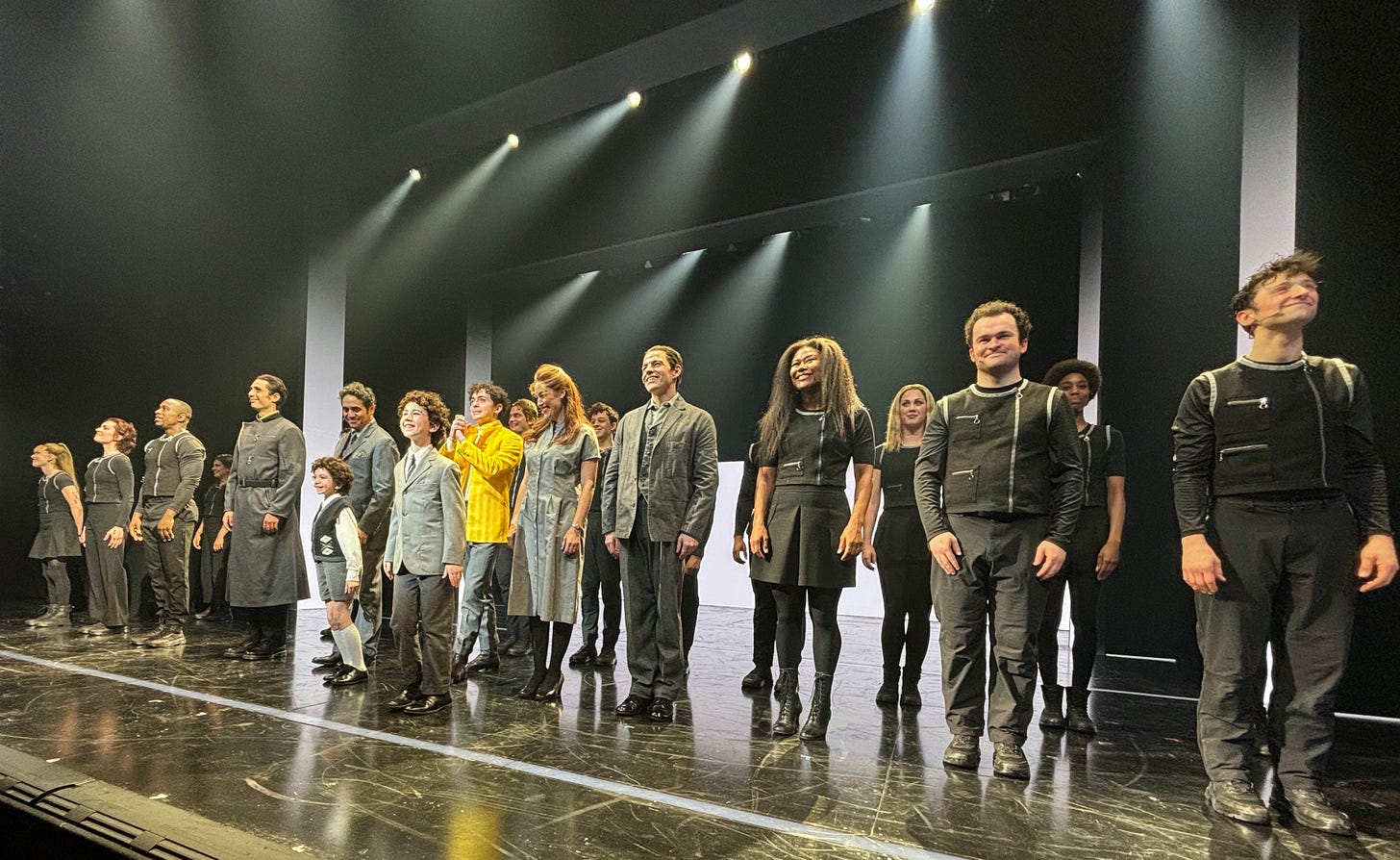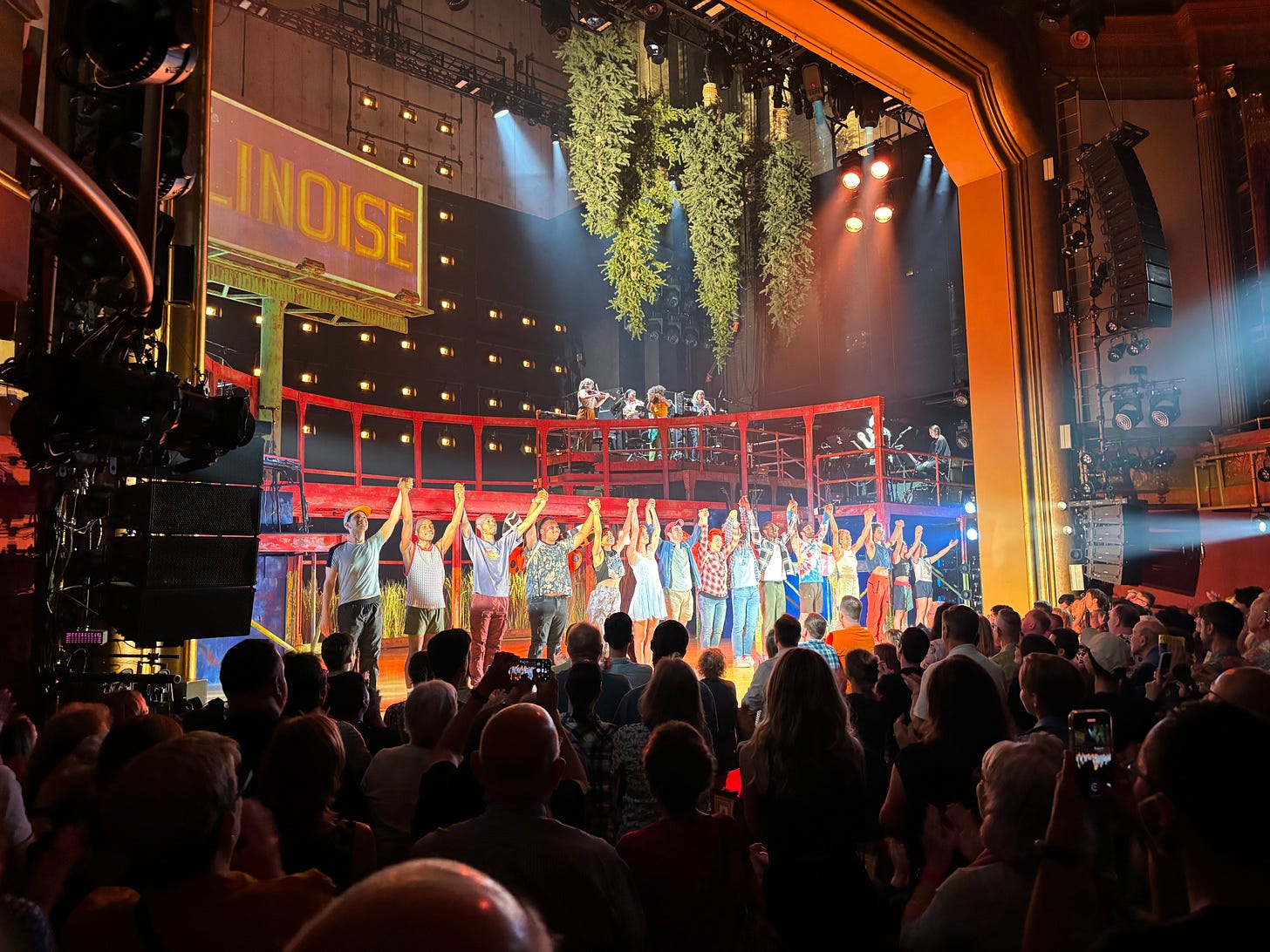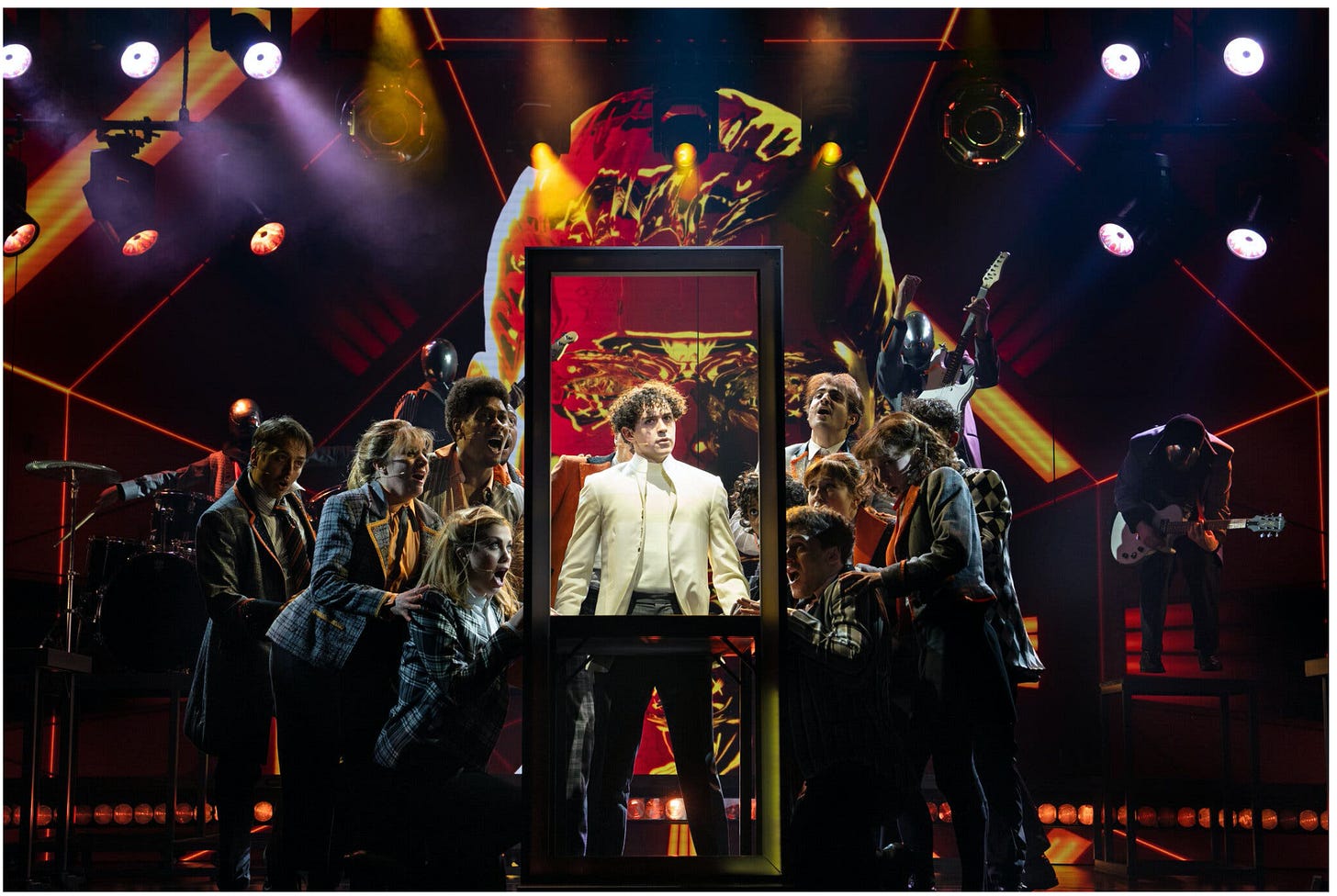NY Reviews: "Illinoise" is a gorgeous and mesmerizing dance musical
Plus the thrilling ride of "The Who's Tommy" and DC previews in brief
Hello, play-goers! I’m back with reviews of two totally different, both excellent musicals playing on Broadway now: the dance musical Illinoise and a revival of the rock opera Tommy.
Mark your calendars for Broadway’s big night, the Tony Awards! They’re broadcasting Sunday, June 16th at 8p on CBS and Paramount+. It’s a great chance to see musical numbers from the nominated shows. Nominations list here.
Great Theatre in DC Right Now
DC readers, we’ve got several intriguing offerings up right now! An innovative new musical, “Mexodus,” is running at Mosaic Theater. Two actors use live looping sound technology to create an orchestra’s worth of instruments and tell the true story of enslaved people in the American South escaping to Mexico (through June 9). The classic “Bye, Bye Birdie” with some great Broadway talent has a short run at the Kennedy Center as part of their Center Stage series (June 7-15). At the newly re-opened Folger Shakespeare Library, a revival of Mary Zimmerman’s “Metamorpohes” features an all-Black cast engagingly transposing the show’s ancient stories onto people throughout the African diaspora (through June 23). Suzan-Lori Parks’s “Topdog/Underdog” is at Round House Theatre; it’s a highly regarded play about two brothers struggling for dominance (through June 23). At Signature, the new musical “Where the Mountain Meets the Sea” tracks a queer son retracing his Haitan immigrant father’s journey set to folk music (through July 7).
Beauty in All Forms Glows in “Illinoise”
The beauty of dance theatre is that the specifics of the story matter far less than the emotional truth evoked through bodies in motion. When done right, that movement speaks directly to our hearts, seemingly bypassing our left brain’s processing center. “Illinoise” is just such a show: with mesmerizing, mysterious music from Sufjan Stevens and gorgeous movement from director-choreographer Justin Peck.
That music is the starting point for this show. It comes from Stevens’s 2005 album, “Illinois,” which tells stories from that state through uncategorizable music. Making use of a range of instruments, it is orchestral but with a rock groove and pop-adjacent melodies. Elliptical, poetic lyrics leave a lot of room for interpretation. Peck (resident choreographer at New York City Ballet) approached Stevens about turning the album into a dance theater piece in 2014. Once Stevens agreed, Peck listened to the songs over and over again, trying to discern the meaning in them. But even if the lyrics provided inspiration for the story, and at times give the audience clues, as another reviewer wrote of the show, “the verbal dials [are] turned way down, and the physical and musical ones way up.” The specifics of the words matter only occasionally—it’s the emotional thrust of the music that forms the core of the story arc. Orchestrations by Timo Andres bring out all the layers in the compositions, while the on-stage band and three singers bring them to vivid sonic life, assisted by the bright and full-volume sound design of Garth Macaleavey.
Of course, there is a story, developed by Peck and co-book writer Jackie Sibblies Drury (Pulitzer Prize winner for the brilliant “Fairview”). A group of young people have gone on a hike and are sitting around the campfire telling stories. As Peck shared in a podcast, this “honor[s] the earliest forms of theatre…humanity gathering around this central light and heat source… [and] they start to entertain one another and share stories.” The first of these—featuring incredible tap dancing—moved me to tears. I’m not even sure my interpretation of the story was the intention of the theatre-makers, but one of the great strengths of this show is that it just doesn’t matter. Not a word of dialogue is spoken and the stories are still compelling from start to finish.
After three more people dance their tales, we come to the main protagonist, Henry, who reluctantly begins to tell his own. It involves unrequited love with a friend; an exciting road trip set to the absolute banger “Chicago;” tragic loss and grief; and hopeful romantic connection with a new man after moving to New York. The lithe Ricky Ubeda imbues Henry with innocence, romance, and anxiety; his every dance step communicates volumes. Ben Cook, Gaby Diaz, and Ahmad Simmons play the other main roles, surrounded by an outstanding ensemble. The story they convey is tragic, but its conclusion hopeful.
Peck’s choreography is rooted in ballet but transcends it. No detail seems too small for him: in a scene with zombies (yes, zombies—it works), I noticed the way one actor’s ankle and foot was splayed unnaturally to convey the scariness of the monster she was portraying. Subtle, but effective. The multiple pas de deux with Henry and his boyfriend are arresting in their beauty, and all the more so because they show two men dancing together. Rarely have I seen queer love displayed so handsomely.
Enhancing the beauty of the piece is lush lighting design from Brandon Stirling Baker, including warm tones of red and orange streaming in during the campfire scenes. A simple set from designer Adam Rigg consists of steel platforms holding up the band, grassy reeds upstage to convey the woods-y setting, and a large billboard, on which projections sometimes convey a bit of information about the story being told.
This musical is a celebration of beauty: music, movement, and queer love. The final scenes reveal an “ah-ha”: Henry’s journey was really towards finding a community to unburden the weight of his loss. Once he did, he could join the ensemble in joyful movement. What would it look like for all of us to share our stories in a supportive community, even if we don’t have the words? “Illinoise” invites us to try.
Playing through August 10 at the St. James Theatre on Broadway.
An Exhilarating Journey in “The Who’s Tommy”
Thrilling. That’s how it felt watching the Broadway revival of “The Who’s Tommy,” the rock opera by Pete Townshend (music, lyrics, and book), and Des McAnuff (book and direction). The score is energizing, toe-tapping rock—groovy throughout. (You probably already know it’s most famous song, “Pinball Wizard”.) Even with an at-times bonkers storyline, you barely have time to feel confused amidst the constant aural and visual stimulation: a new song has begun and the ensemble is strutting and lifting one another up.
That storyline starts like this: At the outbreak of World War II, Tommy’s father goes to fight and is taken prisoner. His wife is told he is most likely dead, and after giving birth to Tommy, starts a relationship with a new man. When Tommy’s father returns home and finds the three together, he shoots the new lover. A four-year old Tommy witnesses the killing, traumatizing him so much that he does not speak or respond to speech for many years. His parents, played by Alison Luff and Adam Jacobs—both with killer vocals—take him to various doctors and psychologists, but nothing works. They even consider allowing an “Acid Queen” to try her unorthodox cure on him. (When my high school did this show, this was how I learned what LSD was!)
But none of it clicks. It’s not until he is in front of a pinball machine, of all things, that he displays any sense of engagement—he has an innate talent for the game. He becomes a sensation for his pinball skill. Playing the title role, Ali Louis Bourzgui makes a stunning Broadway debut. He sings like a rockstar, with a depth in his voice well-suited to the score. He walks the tightrope among the various modes of his character deftly, illustrating his younger self’s inner thoughts; playing the non-responsiveness convincingly; and fully seizing the moment when he finally breaks free of it.
Much of the story is told through dance, and choreographer Lorin Latarro has the athletic ensemble moving, moving, moving all the time. The combination of stylized walking, deep arches backwards, leaps, and flips all suit the material—high energy music with high energy dancing. And the music is LOUD. Sound designer Gareth Owen uses advanced techniques to balance the mix so that as he turns up the volume, he adjusts the frequencies you’re hearing so that you feel it in your bones without it seeming deafening.
The rock concert vibe is further enhanced by David Korins’s giant repeating boxes framing the stage in front of a white backdrop, all of which provide surfaces for Peter Nigrini’s psychedelic projections. A two-way mirror allows older and younger Tommys to see each other looking in the mirror; long tubes of light come in from above and the sides to frame action and continue this central motif. Amanda Zieve’s concert-like lighting design further energizes the action, with giant lights that fly down and shoot out at the audience. In a rock opera with minimal dialogue and only a handful of named characters, Sarafina Bush’s costumes are doing a lot of work to clue us in to who’s who. She dresses the ensemble in individualized yet cohesive costumes, lots of 1960s-London style with a twist.

Eventually, the spell is lifted when his mother breaks the mirror Tommy has been gazing into for years—the same one in which he witnessed the killing. A metaphor for releasing long-held trauma, it’s here that Tommy can finally break free. While exciting, this moment doesn’t feel like the grand climax it should. In some ways, this is a victim of the show’s own success at being so explosive all along. But then the story really goes off the rails, jumping to “the future” (as told via projections). Though it’s no less engaging at this point, this choice felt unnecessarily confusing to me. It seems the theatre-makers were trying to make a grander point than needed.
But the core of the story is enough: A traumatized boy finds something he’s good at and amasses many followers who are fascinated by his pinball skills and miraculous recovery. They all want to be like him, but he’s only ever wanted to fit in with them. In the end, he’s left with just his family. “See me, feel me, touch me, heal me,” he sings. Maybe now his healing can really begin.
Playing an open run at the Nederlander Theatre on Broadway.
***
“Illinoise” and “Tommy” are great examples of the range of ideas—musical, movement, and story—that can coexist on Broadway. They both started as concept albums by singer-songwriters. But that’s where the similarities end. One is a beautiful, delicate queer love story that is moving in its subtlety; another a larger-than-life, exhilarating rock opera. Both make use of the same tools in different ways to provide engaging entertainment.
And reader—I absolutely love it! How exciting to engage with an art form this capacious! I want the theatre to be a place that tells an array of stories in a variety of ways that appeals to as diverse an audience as possible. This season on Broadway, it truly is.
That’s all for now! I’ll be back soon with reviews of “Suffs” and “The Outsiders,” plus coverage of the Tonys. Write to me your picks for the awards!










